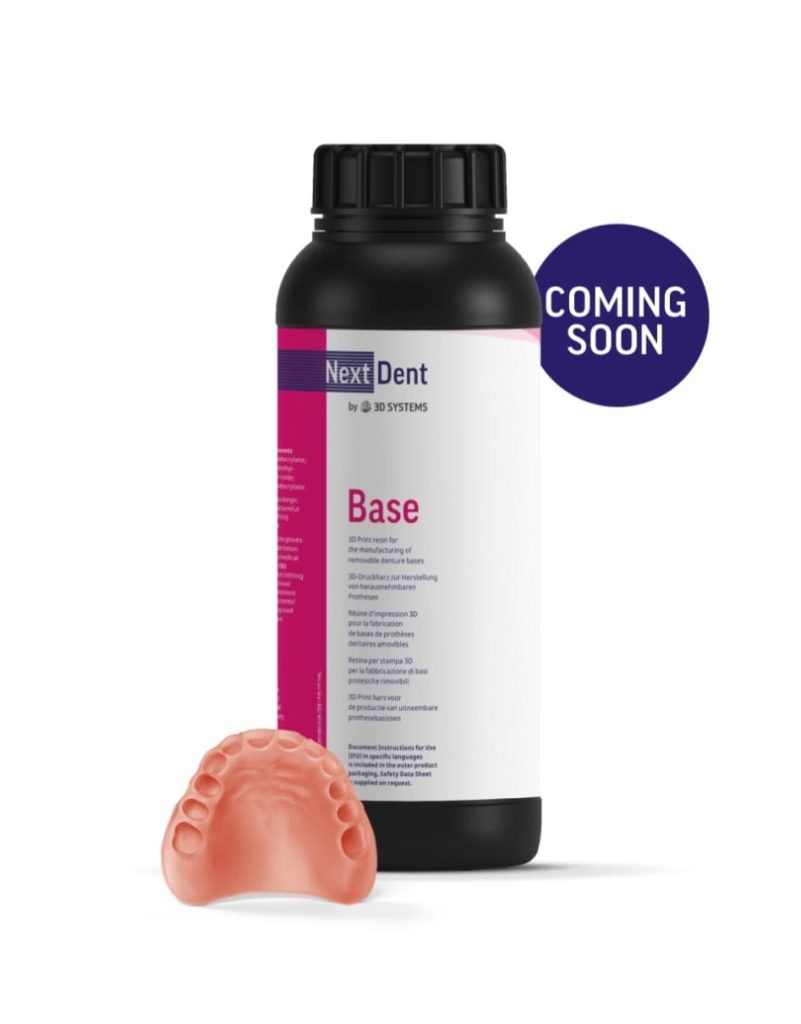3D printer manufacturer 3D Systems has announced the NextDent Base and NextDent Cast 3D printing materials for dental applications, along with the new NextDent LCD1 printing platform.
These offerings assist the company’s customers in accelerating the adoption of Additive Manufacturing as part of their workflows, resulting in increased speed, productivity, efficiency, and accuracy. According to 3D Systems, the 3D printing resins and platform will enable them to enhance patient outcomes.
“We have a rich history as a leading innovator in both 3D printing technology and dental materials,” said Stef Vanneste, Vice President and General Manager, Dental, 3D Systems. “Our goal is to ensure we are addressing our customers’ needs with our solutions, and these enhancements to our portfolio are yet another step in achieving that goal. Both new materials announced today are next-generation materials, specifically engineered with our customers’ feedback on the earlier versions in mind. NextDent Base is a completely new formulation that demonstrates high break resistance and beautiful base shades. We firmly believe that these products will further enable the adoption of 3D printing in dentistry and improve the patient experience.”

3D Systems’ new products to improve dental processes
NextDent Base is an ideal material for 3D printing various types of removable denture bases. It is the third iteration of 3D Systems’ denture base material for 3D printing, and it boasts superior mechanical properties. The R&D team has taken feedback from the previous version of this material, which included requirements for high break resistance and strong printability, as a clear direction for improvement. NextDent Base is comparable to traditional denture base materials and can produce long-lasting and impact-resistant dentures for patients. The material will come in four colors to suit varying aesthetics and is expected to be available for purchase in selected markets later this year.
NextDent Cast is a 3D printing material that burns out easily and leaves no residue, making it a suitable choice for various applications, including RPDs, crowns, and bridges. The latest version of this material produces blue-colored parts that are easier to print and burn out and provide a stable and robust castable part. NextDent Cast is available for ordering immediately.
3D Systems says it is “delighted to introduce” NextDent LCD1, a compact, easy-to-use printer that produces high-quality results. The small size and user-friendly touchscreen interface make it suitable for small office environments with lower production volumes. The NextDent LCD1 uses LCD technology and features auto-calibration to produce parts with a smooth surface finish, which is three times faster than what is achievable with stereolithography (SLA) printers. When combined with the 3D Systems’ resins and NextDent Wash & Cure for post-processing, clinicians can easily achieve high-quality results with a straightforward workflow. The NextDent LCD1 is also available for immediate ordering.
3D Systems showcased its full portfolio of digital dentistry solutions, including these latest products, at IDS 2023.

Demand for 3D printing technologies in the dental sector
A report from Vantage Market Research has indicated that the worldwide market for 3D printing in dentistry was valued at USD 2.13 billion in 2021 and is predicted to grow to USD 7.22 billion by 2028. The dental 3D printing sector is expected to experience substantial growth compared to the anticipated market during this period, with a compound annual growth rate (CAGR) of 30.1%. Consequently, dental 3D printing companies are contributing to this prediction.
Leading 3D printing company Carbon, introduced a new production option for the dental 3D printing sector that enables the 3D printing of clear aligners. The production solution, which was unveiled at IDS last week, focuses on sustainability and delivers substantial cost savings. It offers up to a 65% increase in throughput and requires less material per print, resulting in a significant reduction in cost per part while boosting overall throughput. Carbon’s Gen 2 aligner model solution includes new proprietary software and high-performance resin that seamlessly integrates with Carbon’s existing 3D printing systems and aligner model workflow.
Earlier this year, Stratasys, a manufacturer of 3D printers, and 3Shape, a Danish company specializing in 3D scanning and software, jointly developed a color workflow for automated 3D printing that utilizes 3Shape’s Dental System software and the Stratasys J5 DentaJet 3D printer. This technology allows dental laboratories to capture the geometric and color information of a patient’s mouth using an intraoral scanner and 3Shape software. The data can then be imported into Stratasys’ 3D printer, which produces precise, customized, and full-color dental models.
What does the future of 3D printing for the next ten years hold?
What engineering challenges will need to be tackled in the additive manufacturing sector in the coming decade?
To stay up to date with the latest 3D printing news, don’t forget to subscribe to the 3D Printing Industry newsletter or follow us on Twitter, or like our page on Facebook.
While you’re here, why not subscribe to our Youtube channel? Featuring discussion, debriefs, video shorts, and webinar replays.
Are you looking for a job in the additive manufacturing industry? Visit 3D Printing Jobs for a selection of roles in the industry.
Featured image shows NextDent LCD1 printing platform. Image via 3D Systems.



